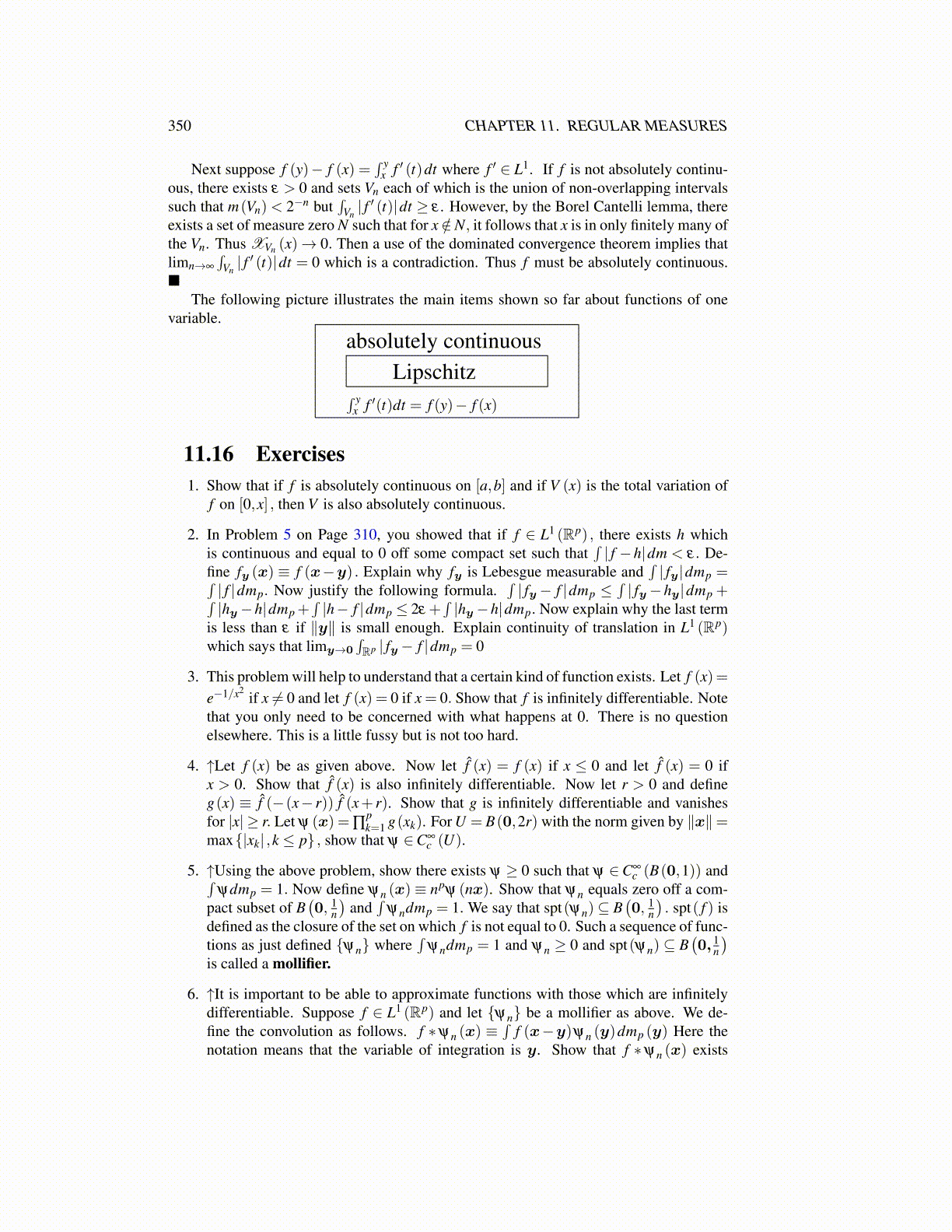
350 CHAPTER 11. REGULAR MEASURES
Next suppose f (y)− f (x) =∫ y
x f ′ (t)dt where f ′ ∈ L1. If f is not absolutely continu-ous, there exists ε > 0 and sets Vn each of which is the union of non-overlapping intervalssuch that m(Vn)< 2−n but
∫Vn| f ′ (t)|dt ≥ ε . However, by the Borel Cantelli lemma, there
exists a set of measure zero N such that for x /∈N, it follows that x is in only finitely many ofthe Vn. Thus XVn (x)→ 0. Then a use of the dominated convergence theorem implies thatlimn→∞
∫Vn| f ′ (t)|dt = 0 which is a contradiction. Thus f must be absolutely continuous.
■The following picture illustrates the main items shown so far about functions of one
variable.
Lipschitzabsolutely continuous
∫ yx f ′(t)dt = f (y)− f (x)
11.16 Exercises1. Show that if f is absolutely continuous on [a,b] and if V (x) is the total variation of
f on [0,x] , then V is also absolutely continuous.
2. In Problem 5 on Page 310, you showed that if f ∈ L1 (Rp) , there exists h whichis continuous and equal to 0 off some compact set such that
∫| f −h|dm < ε. De-
fine fy (x) ≡ f (x−y) . Explain why fy is Lebesgue measurable and∫| fy|dmp =∫
| f |dmp. Now justify the following formula.∫| fy− f |dmp ≤
∫| fy−hy|dmp +∫
|hy−h|dmp +∫|h− f |dmp ≤ 2ε +
∫|hy−h|dmp. Now explain why the last term
is less than ε if ∥y∥ is small enough. Explain continuity of translation in L1 (Rp)which says that limy→0
∫Rp | fy− f |dmp = 0
3. This problem will help to understand that a certain kind of function exists. Let f (x)=e−1/x2
if x ̸= 0 and let f (x) = 0 if x = 0. Show that f is infinitely differentiable. Notethat you only need to be concerned with what happens at 0. There is no questionelsewhere. This is a little fussy but is not too hard.
4. ↑Let f (x) be as given above. Now let f̂ (x) = f (x) if x ≤ 0 and let f̂ (x) = 0 ifx > 0. Show that f̂ (x) is also infinitely differentiable. Now let r > 0 and defineg(x) ≡ f̂ (−(x− r)) f̂ (x+ r). Show that g is infinitely differentiable and vanishesfor |x| ≥ r. Let ψ (x) = ∏
pk=1 g(xk). For U = B(0,2r) with the norm given by ∥x∥=
max{|xk| ,k ≤ p} , show that ψ ∈C∞c (U).
5. ↑Using the above problem, show there exists ψ ≥ 0 such that ψ ∈C∞c (B(0,1)) and∫
ψdmp = 1. Now define ψn (x) ≡ npψ (nx). Show that ψn equals zero off a com-pact subset of B
(0, 1
n
)and
∫ψndmp = 1. We say that spt(ψn)⊆ B
(0, 1
n
). spt( f ) is
defined as the closure of the set on which f is not equal to 0. Such a sequence of func-tions as just defined {ψn} where
∫ψndmp = 1 and ψn ≥ 0 and spt(ψn) ⊆ B
(0, 1
n
)is called a mollifier.
6. ↑It is important to be able to approximate functions with those which are infinitelydifferentiable. Suppose f ∈ L1 (Rp) and let {ψn} be a mollifier as above. We de-fine the convolution as follows. f ∗ψn (x) ≡
∫f (x−y)ψn (y)dmp (y) Here the
notation means that the variable of integration is y. Show that f ∗ψn (x) exists